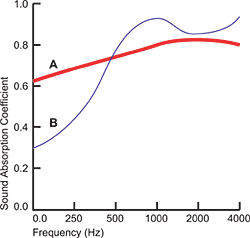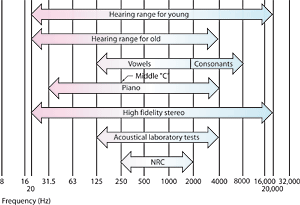|
Sound is the auditory perception of vibration
or pressure oscillations that occur in the air
around us. The pitch of a tone can be analyzed
in terms of frequency and is expressed in hertz
(Hz), the number of vibrations or pressure oscillations
that occur per second. Humans can generally hear
from 20 Hz (low pitch) to 20,000 Hz (high). While
we enjoy this full spectrum when listening to
a symphony, the critical frequencies for understanding
speech typically occur at mid-range frequencies
between 125 Hz and 4,000 Hz. Most noises contain
a combination or range of frequencies occurring
simultaneously.
The intensity or loudness of a sound is related
to sound pressure and is expressed in decibels
(dB). Because decibels are logarithmic units,
a change of 3 dB will be barely noticeable but
a 10 dB change will appear twice (or half) as
loud. Zero dB represents the threshold of audibility
and sound pressures above 100 dB are loud enough
to cause deafness and pain. Ours is an increasingly
noisy society, and occupational health and safety
regulations limit the duration for which a person
may be exposed to very loud noise. Even in less
noisy environments, however, attention must be
given to noise control if we are to provide optimum
living, working and listening conditions.
Noise is propagated and travels in waves in much
the same way as ripples spreading out from a pebble
tossed in water. Visualizing this can help to
understand how sound is reflected when it encounters
a hard dense surface, absorbed when it enters
a resilient or porous material, or transmitted
through a lightweight construction. Sound waves
can also be focused or dispersed depending on
whether they reflect from a concave or convex
surface.
When designing the acoustical environment of
a room, one begins by identifying the sources
and characteristics of sounds in the space and
by defining the acoustical criteria (such as loudness,
reverberation, speech intelligibility, etc.) that
are required by its occupants. The acoustics of
an open office or restaurant, for example, must
enable occupants to have intelligible yet private
conversations. And in auditoria and conference
rooms, sound must be carefully distributed so
that performers or speakers can be clearly heard
throughout the room. Once these project parameters
are determined, ceiling and wall systems can be
designed to reinforce desirable sounds and attenuate
undesirable noises.
The noise reducing potential of panels is determined
with ASTM C 423 - Standard Test Method for Sound
Absorption and Sound Absorption Coefficients by
the Reverberation Room Method. Note that test
results can vary depending upon how panels were
mounted in the test chamber: a test report that
replicates the installation conditions expected
on the job site should be used. The percent of
noise absorbed is typically calculated at six
frequencies from 125 Hz to 4000 Hz. To simplify
comparisons between acoustical products, the noise
reduction coefficient (NRC) is the average of
sound absorption tests at 250, 500, 1000, and
2000 Hz, rounded to the nearest multiple of 0.05.
These mid-range frequencies are used because they
cover the spectrum most important for spoken communication.
While an NRC is useful for preliminary product
screening, it should not be relied upon for final
product approval. When test data are plotted on
a graph, they usually form a gradual curve; a
peak in the curve indicates that the tested material
is especially efficient at absorbing certain frequencies.
This could be desirable if, for example, one needs
to dampen the whine from a machine operating at
that particular frequency. But if the same insulation
were used in a music hall, it would have the disconcerting
effect of hushing certain notes. For this reason,
it is good practice to ask panel manufacturers
to furnish complete product test reports prepared
by qualified, independent acoustical laboratories,
especially when designing spaces where high quality
acoustics are essential.
It is important to match the reverberation time
of a space to the type of listening environment
required. Reverberation is the persistence of
a sound after the source of the sound has stopped;
the time it takes for the sound to "decay"
to a point of inaudibility. In a room surrounded
by hard, reflective materials, sound bounces from
surface to surface and may continue to echo or
reverberate for several seconds. These reverberations
could make conversation or music difficult, since
each syllable or note would echo back and forth
and interfere with the ability to distinctly hear
subsequent syllables and notes. Offices and recording
studios, consequently, are generally designed
to have short reverberation times; a reverberation
time less than 1 second is generally suitable
for a conference room or class room. In other
spaces, however, a longer reverberation time may
be desirable. Reverberation times of 2 or 3 seconds
may be desirable in a symphonic hall or church
to allow the music to have a "live"
feel. For example, the long, sustained notes of
a pipe organ or choir can help to create the proper
liturgical atmosphere in a cathedral.
The following formula is used to predict a room's
reverberation time:
T = 0.05 V/a
where:
T = reverberation time, the time required for
a sound to decay 60 dB, in seconds
V = room volume in cubic feet
a = the total amount of sound absorbing material
in a room, measured in Sabins. (A Sabin is equal
to one square foot of surface that absorbs 100%
of the sound falling on it. For example, a window
with one square foot of open area would have one
Sabin since all of the sound energy impinging
on the window would leave the room.)

Noise
reduction is tested at six frequencies,
but only four mid-range values
are averaged to obtain a Noise
Reduction Coefficient (NRC). The
graph shows two panels with the
same NRC; however "A",
has better overall performance,
especially in the lower frequencies
that are critical for speech. |
|
|
Based on this, the reverberation time can be
decreased by using perforated panels with acoustical
insulation to increase the sound absorption (a)
in a space. Alternatively, reverberation time
can be increased by using acoustically transparent
perforated panels to increase the volume (V) of
the space. |











